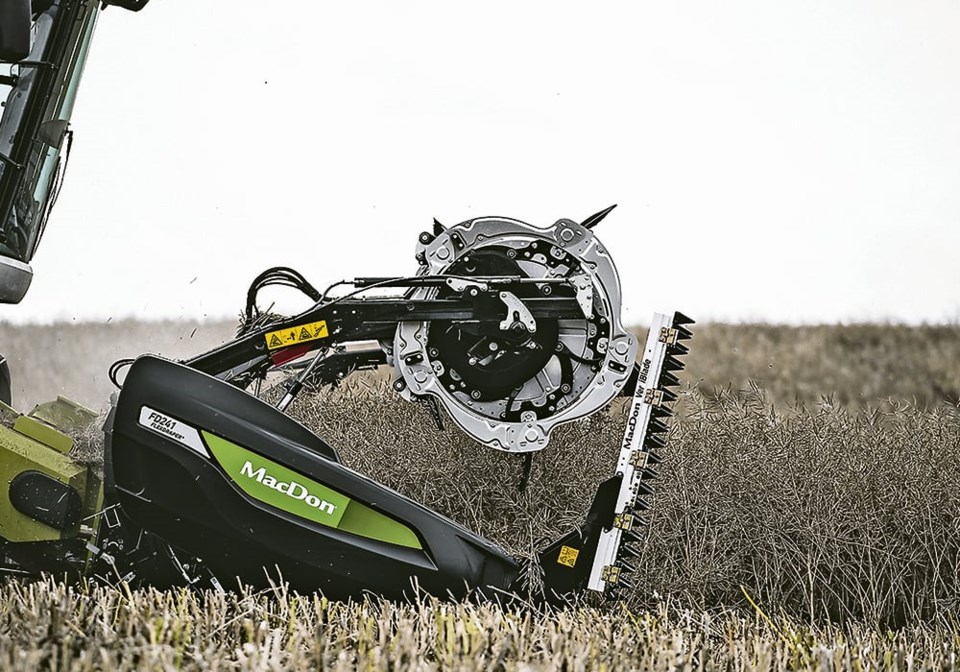WESTERN PRODUCER — Every year we hear more stories of lost grade, lost bushels and lost income because crop was harvested too late. Meanwhile, combines, grain carts, trucks and handling facilities sit idle because there are not enough qualified operators.
“Newbies running expensive equipment. That’s what’s driving this whole move toward autonomous implements,” says Ryan Georgison, manager of research and development at MacDon Industries.
The expansion of big-acreage farms has created its own problem — the disappearance of knowledgeable neighbours who can be hired during the busy seasons.
Georgison said there’s nothing wrong with hiring a high school kid to run a combine, if that kid has already been running machinery for six years. The problem is that there are no more such neighbours. They disappeared when you bought their land.
He’s working toward providing at least a partial solution to the problem. The project is called Harvesting Automation — Reducing the Requirement for Highly Skilled Labour During the Harvest of Broad-Acre Cash Crops.
An operator normally monitors the various functions of the combine and makes adjustments according to what they see happening. The human eyeball is the sensor that feeds information to the operator, who then makes appropriate adjustments.
However, high-powered electronic sensors can see minute changes in the crop flow that the human eye cannot detect. A digitalized data system can take multiple readings in the time it takes a human eye to blink.
“When it comes to finding good operators, farmers are doing more with less. There’s more need for operators but there’s fewer operators available. We’re making the combine more operator friendly.
“In our research, we saw there’s three levels of competence. The optimal operator, the seasoned operators, these people don’t need much help. The problem is there’s so few of them. Then there’s the average operator. These automated systems will improve the average performance of the combine when he’s running it.
“And then there’s the newbie who is not a farm kid and he doesn’t know much about machinery.
“Farming is going to see a trend toward more of these people leaving the city to come work on these large, consolidated farms. That’s where automated systems really shine,” Georgison said.
He said the ultimate goal is to design and produce a product that cuts grain, oilseeds and pulses so precisely that it will be superior to original equipment manufacturer systems that come standard. MacDon’s engineers and technologists are working to automate the crop-engagement portion of a combine and the user interface inside the cabin.
“We devote a lot of time and effort to studying different types of equipment to ensure our technology integrates seamlessly with as many OEM machines as possible. We’re trying to reduce the effort of operators as they spend long hours harvesting.
“One of the things that sets us apart is the time we spend consulting our customers during the design process. I often take prototypes out to the field and engage with farmers to find out what works and what doesn’t. I grew up in a dairy operation so I can speak ‘producer’ and bridge the world of ag and engineering,” Georgison said.
Because this product is typically an aftermarket addition, and since harvesters vary, one of the big challenges is designing a solution that can be installed on any brand of new combine or retrofitted on an older model.
“Our traditional strengths have been in the areas of mechanical design and hydraulics. To succeed with this project, we’ve had to add competencies in automation, sensor technology, machine learning and AI. With (the Canadian Agri-food Automation and Intelligence Network’s) funding, we’ve been able to attract the right people.
“The crop is where the money is. Crop should not still be on the field after the combine harvester has passed, no matter how old the combine is.”
The total budget for the project is $9,351,260. Of that amount, the network contributed $3,839,381.




